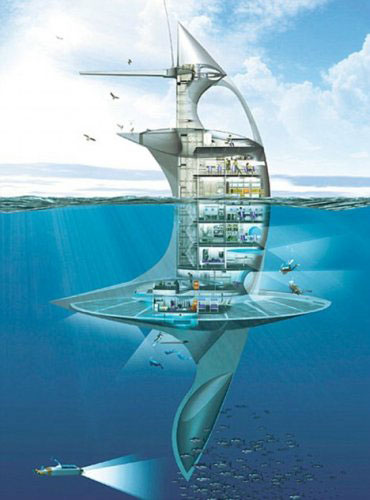SeaOrbiter - 'Space Station' on the ocean floor
SeaOrbiter (the combination of a seahorse with the famous Enterprise spacecraft in the Star Trek super product), the world's first vertically underwater operating ship, and a means of enabling humanity to study ocean better.
Jacques Rougerie, France's renowned ship designer, is a passionate person for rivers and seas. His car is capable of traveling on roads and underwater. Rougerie's house and office were located on a ship and he himself had time to live on the seabed for 70 days.
'Only in the past 50 years have we discovered that there are also four seasons in the water, desert, forests and even rich fauna. Future food and medicine will come from the ocean. Now we are starting to realize that the ocean has a big role in the balance of this planet, ' Rougerie said.
The love of the sea and the desire to explore the mysteries of the ocean prompted Rougerie to launch SeaOrbiter, the world's first vertical underwater operation, with a height greater than its length.
Despite the shape of a spaceship, SeaOrbiter is in fact a floating system with the ability to follow tidal currents or stand still in place thanks to the electric motors on board.
This ship is 51m tall, 10.35m long and 16.12m wide, the largest part of the ship with a height of over 31m is completely submerged under water. When launched, this ship only jutted to the water about 20m.

The shape and idea of the ship reminds people of the Nautilus in "20 thousand miles of seabed". Rougerie also admitted that he got the idea from Jules Verne's famous work. But this ship's goal is not to fight humanity.
'At present, oceanographers can only dive into the sea for a short time before people have to drag them to shore. This is like they were taken to study in Amazone forest and after a few hours, they have to go on a helicopter somewhere to relax, ' he said.
Under water, the vessel contains balanced equipment, fuel storage tanks and fresh water. At the bottom there are two antennas to observe the sea. Ship consists of 8 floors, 5 under water. The two floors closest to the sea floor will be designed to become rooms with air pressure equal to the water pressure outside.
Divers can live here and are always ready to go out to the sea to work or return to the ship immediately without the need to handle increased pressure drop, something that must be done during normal diving to avoid body imbalance.
Above these two floors, there will be a group observing the ocean floor and conducting research on the marine environment, marine ecosystem, biodiversity and fish resources.
The floating floors of SeaOrbiter will be devoted to studying water, climate change, the relationship between global warming and ocean . 18 people can live in this closed world at the same time. , including 8 professional divers in the bottom area.
Some units such as the US Aeronautics and Space Agency (NASA) and Europe (ESA) have expressed interest in participating in the SeaOrbiter project. They wanted to use this ship as a training ground for astronauts because the water environment provided conditions like the non-gravity environment.
Underwater astronaut training is not a new idea. NASA has an offshore training center in Florida and Scott Carpenter, one of the first American astronauts, is now part of the SeaOrbiter research group. Carpenter was also one of the first astronauts to propose the idea of underwater training in 1964.
Rougerie said, he was very confident in the possibility of the ship being successfully closed: 'A year ago, the possibility was 50/50. But now, I believe it has a 90% chance of being a reality. '
French President Nicolas Sarkozy mentioned this project in an important speech about the sea this summer and received the support of shipbuilder DCNS as well as Thales defense electronics group.
The SeaOrbiter closed project is still progressing well. A model has been tested in the Marintek center, Norway, to ensure it can withstand big waves.
The team is looking for more industrial partners to pay a fee of up to 35 million euros for SeaOrbiter operations, but they plan to launch the ship in 2011, first in the Mediterranean.
SeaOrbiter's first mission, scheduled to take place in 2012, will be 'wandering' according to the Gulf Stream, just as Jacques Piccard did 40 years ago.
- SeaOrbiter - Dream ocean research station
- Explore the ocean
- Video: The scenery on the ocean floor if the water is dry
- Space station in the ocean
- The 10 most shocking mysteries of the ocean floor
- ISS will rest in the Pacific Ocean
- China plans to launch Tiangong Space Station similar to ISS by 2020
- New strange creatures are found on the deep ocean floor
- Overview of China's Thien Cung 1 Space Station
- How did the Soviet Union save the Saliut-7 space station?
- NASA celebrates 40 years of the first space station project
- Russian space station will replace the US ISS global surveillance
 Norway built the world's tallest wooden tower
Norway built the world's tallest wooden tower Kremlin
Kremlin Ashurbanipal: The oldest royal library in the world
Ashurbanipal: The oldest royal library in the world Decoding the thousand-year construction of Qin Shihuang shocked the world
Decoding the thousand-year construction of Qin Shihuang shocked the world